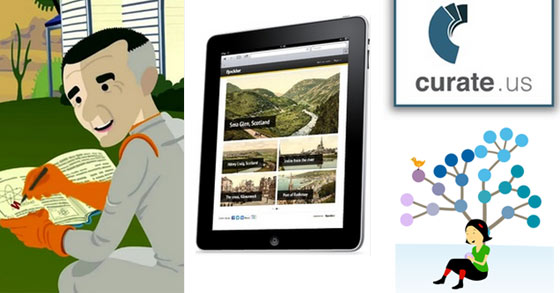
Scoop.it, Storify, Pearltrees let you become a niche authority
This is the second of a two-part series. See part 1:
• 7 smart techniques for content curation
Target audience: Nonprofits, cause organizations, foundations, NGOs, social enterprises, businesses, educators, journalists, general public.
 By now you’ve likely heard of content curation, the process of collecting and cataloging the most useful or interesting things about a topic in order to share it for the common benefit. In part 1, Beth Kanter looked at 7 smart techniques for content curation. Today we’ll explore some of the best tools for doing so.
By now you’ve likely heard of content curation, the process of collecting and cataloging the most useful or interesting things about a topic in order to share it for the common benefit. In part 1, Beth Kanter looked at 7 smart techniques for content curation. Today we’ll explore some of the best tools for doing so.
Keep in mind, there are lots of different ways to curate. Jorn Barger started Robot Wisdom, one of the oldest blogs on the Web, back in 1995 as a compendium of pointers to the top blog posts and articles he spied; Amy Sample Ward continues that tradition for the nonprofit community today. Others use Twitter or Facebook as retweeting and sharing engines, pointing to the best items that flit across their radar screens.
More often, though, the new breed of content curation tools refers to sites and services specifically geared for finding the diamonds in the rough. (I won’t be including aggregation services like Alltop, which provide a firehose of news updates about a topic such as nonprofits.)
Here, then, are Socialbrite’s six top tools for content curation. They are free except where noted.
Scoop.it: Become an authority in your vertical
1Scoop.it (tagline: “share ideas that matter”) ranks as one of the top content curation tools right now. The service, which has both free and premium versions, styles itself as a series of online magazines centered on niche topics. Pick a topic you feel knowledgeable or passionate about and start adding to your collection: articles, blog posts, Twitter lists, videos and so on. Socialbrite’s Debra Askanse, for example, has Scoop.it pages on Facebook and Twitter best practices.
Gabriella Sannino put it well: “Scoop.it is like being your own newspaper editor.” The quality of the curators on Scoop.it is high, though you’ll need to root around a bit to find the subjects and authorities that interest you the most. Note: While you can embed it on your own site, it works better by viewing the topics on the main Scoop.it site.
Storify: Curate your next event
2Next time you’re covering a nonprofit conference or putting on an event, consider firing up a Storify account and then pick and choose the best images, tweets, blog posts, videos, etc., that others publish and tie them up with a nice ribbon — your overall take on the proceedings, of course. Storify is becoming a favorite of bloggers, journalists and Tweeps who like its curated take on current events. You can pull from blogs, Twitter, Facebook, YouTube, Flickr, Instagram and many other sources and then export it to your WordPress, Tumblr or Posterous blog or share it on Twitter, Facebook or Google Plus via social buttons. (Side note: I know the founder, Burt Herman, who’s a nice guy, and I always root for former-journalists-turned-entrepreneurs.)
Pearltrees: Cultivate your interests
3My vow for the fall is to spend more time with Pearltrees, which recently did a reboot and looks to be one of the most advanced tools you can add to your curation toolkit. There’s a bit of a learning curve, but here’s how it works: Your browser app lets you “pearl” the page you’re visiting. Connect your Twitter and Facebook accounts, then start organizing interests into topic folders (“pearltrees”). Any other curator expert in your topic area might ask to team up with you (and vice versa) to make your tree branches richer. You can share your pearls through Twitter, Facebook, email or embed them in your own site. You can also share pearls with colleagues or your own team. Curators, behold the potential of the pearl.
Pinterest: Share your favorite visuals
 4Pinterest entreats you to “organize and share the things you love,” but it’s really all about compelling visuals. (And, by the way, here’s a Pinterest board on curation tools.) This year Pinterest has become the third most popular social network in the world, trailing only Facebook and Twitter, by making it drop-dead simple to “pin” images that you think are cool. The more serious Pinterest curators create boards around topics, like nonprofit marketing strategist Noland Hoshino. You can, too.
4Pinterest entreats you to “organize and share the things you love,” but it’s really all about compelling visuals. (And, by the way, here’s a Pinterest board on curation tools.) This year Pinterest has become the third most popular social network in the world, trailing only Facebook and Twitter, by making it drop-dead simple to “pin” images that you think are cool. The more serious Pinterest curators create boards around topics, like nonprofit marketing strategist Noland Hoshino. You can, too.
Delicious: Find & bookmark cool stuff
5Delicious, the first social bookmarking site, is arguably the granddaddy of the curation movement. Now that Yahoo! sold the service to YouTube co-founder Chad Hurley, there’s wind in its sails again. It’s pretty simple: Find a valuable story or post, bookmark it and share it with the community. Your tags can be used by you or anyone (if you select public rather than private). The collective body of knowledge on any topic — such as wildlife, bears or HIV prevention — is simply staggering.
Bundlr: Bundle your multimedia
6With Bundlr you can create topic pages with photos, videos, tweets and documents and then share them with everyone. I haven’t used the service but it looks to be influenced by the Pinterest craze.
BagTheWeb: Add to a knowledge network
7OK, now we’re getting a bit repetitive. BagTheWeb helps users curate Web content through a different metaphor: Create a “bag” to collect, publish and share any content from the Web. One interesting twist is that BagTheWeb enables users to build networks of bags so that topic areas can be linked together to provide rich datasets about any subject.
Other curation services worth checking
Other social curation services worth a look include:
• Chill is a video-centric curation service that lets you vote up stories (mostly locally produced video), Digg style.
• Diigo is the social bookmarking site, research tool and knowledge-sharing community I’ve been using for the past two years.
• Paper.li, Flockler, LOUD3R and Searcheeze are among the new breed of DIY instant news publications on niche topics.
• Qrait is “a real-time curation platform designed to fulfill the needs of content curators and reduce information overload for the rest of us.”
• Curation Station, a paid service, can be used to help you create streams of curated content for your community through websites, social channels, email digests, widgets and more.
• Locker Project provides users a locker, “a container for personal data, which gives the owner the ability to control how it’s protected and shared.”
Related
• Curation tools to help you cope with info-overload (Socialbrite)
• Top tools to help you curate business content (Socialmedia.biz)
• Content Curation Tools For Brands (Return on Clicks)
• 5 tools to help you master Pinterest (Socialbrite)
• My review of “Curation Nation” (jdlasica.com)
• Scoop This: A Comprehensive Guide to Scoop.it for Content Curation (Search Engine Journal)
 This work is licensed under a Creative Commons Attribution 3.0 Unported.
This work is licensed under a Creative Commons Attribution 3.0 Unported.


























